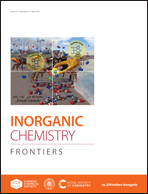Highly efficient CO2 capture and conversion of a microporous acylamide functionalized rht-type metal–organic framework†
Abstract
The design and synthesis of highly porous MOFs with excellent framework stability and optimized supramolecular host–guest interactions is an effective strategy to obtain high-performance MOF materials for targeted applications such as gas storage, separation, catalysis and so on. Herein, we designed and constructed a microporous (3, 24)-connected rht-type acylamide functionalized MOF (HNUST-9) from dicopper(II)-paddlewheel clusters and a novel C2-symmetric acylamide-linking hexacarboxylate. Interestingly, with a high density of strong CO2 binding sites including open copper(II) sites and acylamide groups integrated in the framework, although exhibiting moderate porosity (a BET surface area of 2429 m2 g−1), the activated HNUST-9 shows an exceptionally high excess CO2 uptake capacity (21.8 mmol g−1 at 25 bar and 273 K), and efficient CO2 separation ability from CO2/CH4 and CO2/N2 binary gas mixtures under dynamic conditions at 1 bar and room temperature. Moreover, HNUST-9 demonstrates efficient catalytic activity for the CO2 cycloaddition with various epoxides in the presence of tetrabutylammonium bromide as the cocatalyst under mild, solvent-free conditions.



 Please wait while we load your content...
Please wait while we load your content...